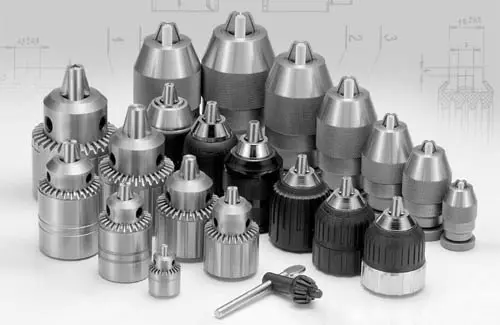The regular price is the current manufacturer's recommended price! FREE shipping for orders over EUR 41,67 within CZ+SK (PPLparcel)

We always choose a drill chuck according to the type of attachment. There are several standard chuck sizes, the choice depends on how you want to use the drill.
Chucks differ in design and method of installation on the tool, we have 2 types:
1) KEYED CHUCKS
The main difference between the keyed and quick-released chucks is the fact that the keyed chucks are more reliable. The tool shank is clamped using a key. This key is made in the shape of T and, when turned, moves a cogwheel, which causes the collar to rotate around the lock, which is responsible for opening or closing. They can be with thread or cone clamping. Thanks to the toothed mechanism for tightening the jaws, it offers greater clamping force than a keyless chuck. They are always all-metal and are designed for hand or stationary drills in many industrial fields.
2) QUICK-RELEASE CHUCKS
They are designed for quick manual clamping of the working tool to the machine. They are among the most popular, as locking the tool takes only a few seconds and there is no need to use a special key. Clamping the shank is done by manually turning the adjusting sleeve, on the outer surface of which there is a corrugation that facilitates this procedure. When fastening the drill, it is important to hold the lower sleeve with one hand and then tighten the upper sleeve with the other hand in a clockwise direction. The disadvantage of quick-release chucks lies in its mechanism, which can wear out over time and the drill shank can rotate. They are available in plastic and metal versions (Lock HM, machine) with thread or cone.
ADVANTAGES
No additional tool (key)
Attachment with one hand
High speed of changing attachments
DISADVANTAGES
Less reliability
Rapid wear
Another very important parameter of the drill chuck is its spindle mounting system:
1) Threaded clamping
- the dimensions of the clamping threads are UNF 3/8, UNF 1/2, UN 5/8. There is also a chuck with an M14x2 thread for angle grinders.
2) Self-locking cone
- it is used mainly with bench drills. They are marked B10, B12, B16, B18, B22.
A reduction will help us to screw a classic threaded chuck onto an SDS+ drill.
CHANGING THE DRILL CHUCK
First, prepare a flat wrench to grip the drill spindle. The exact size may vary for each drill, but for example, a 17mm combination wrench can be used for a Narex drill. You will also need an L hex key of size 8-10mm. Use a Phillips screwdriver if the chuck is tightened to the spindle with a locking screw. However, be careful here, you must always loosen it to the right. The chuck is usually very firmly tightened and therefore you must exert a lot of effort when loosening. Here, a screw extractor can help you, which you apply to the thread and extract the rusty joint.
Put the flat wrench on the spindle, clamp the hex key in the chuck so that it forms an angle of 45-60° with the washer. Then, simply loosen the chuck to the left with enough force and speed (all at once). Once the chuck starts to turn, unscrew the chuck from the spindle and you're done.

Other articles:
Zástrčné klíče
Rázové utahováky
Standartní vrtáky do kovu s novou geometrií CZ002 a CZ004
Jak vybrat strojní závitník?